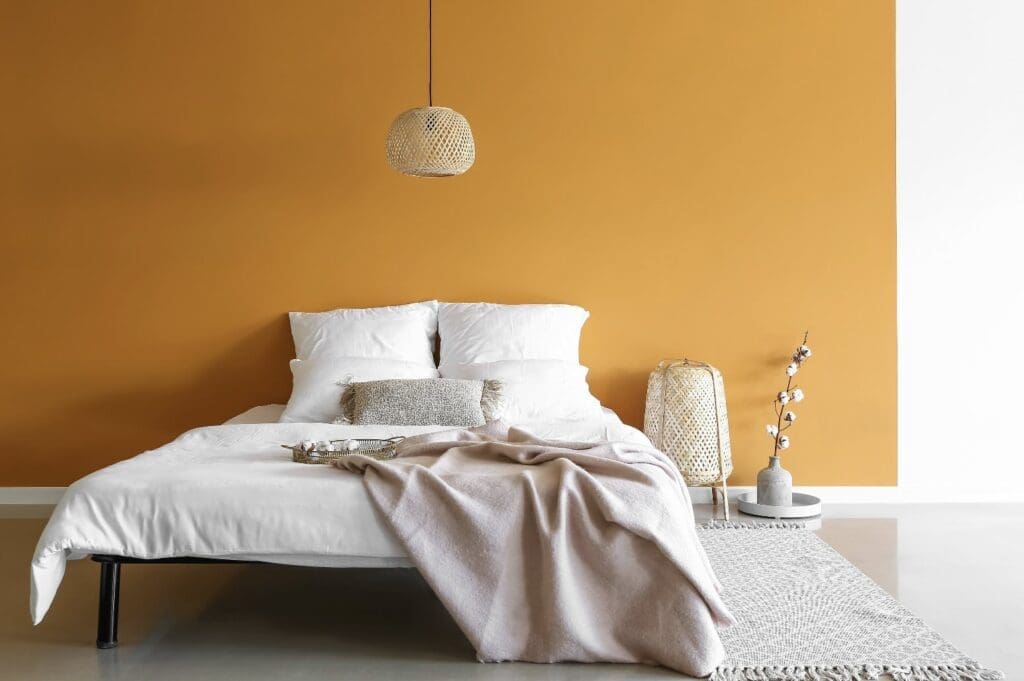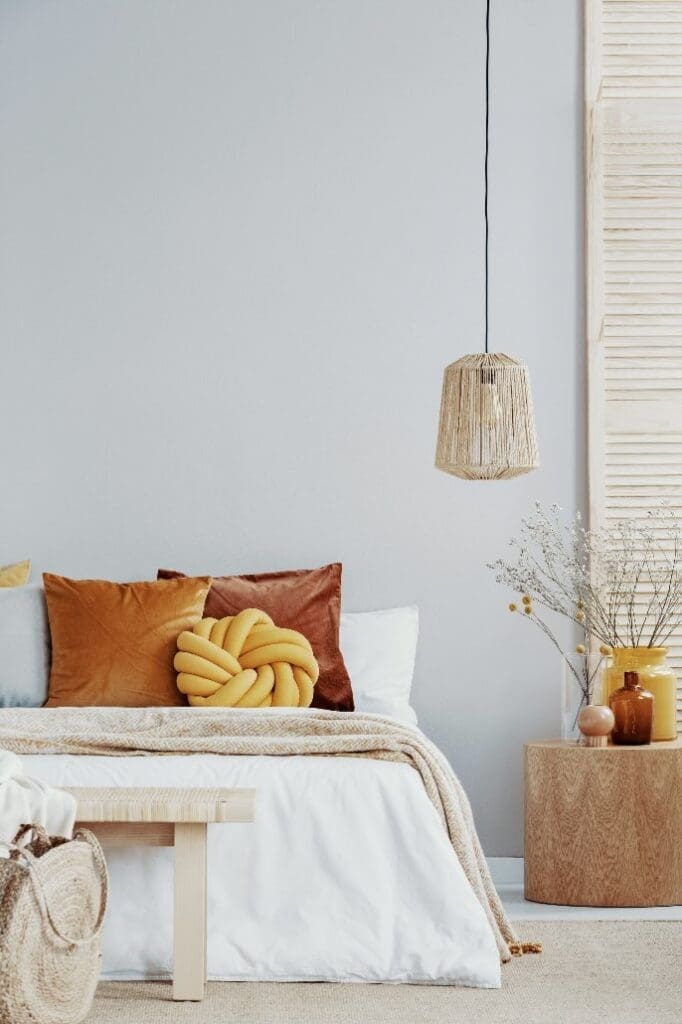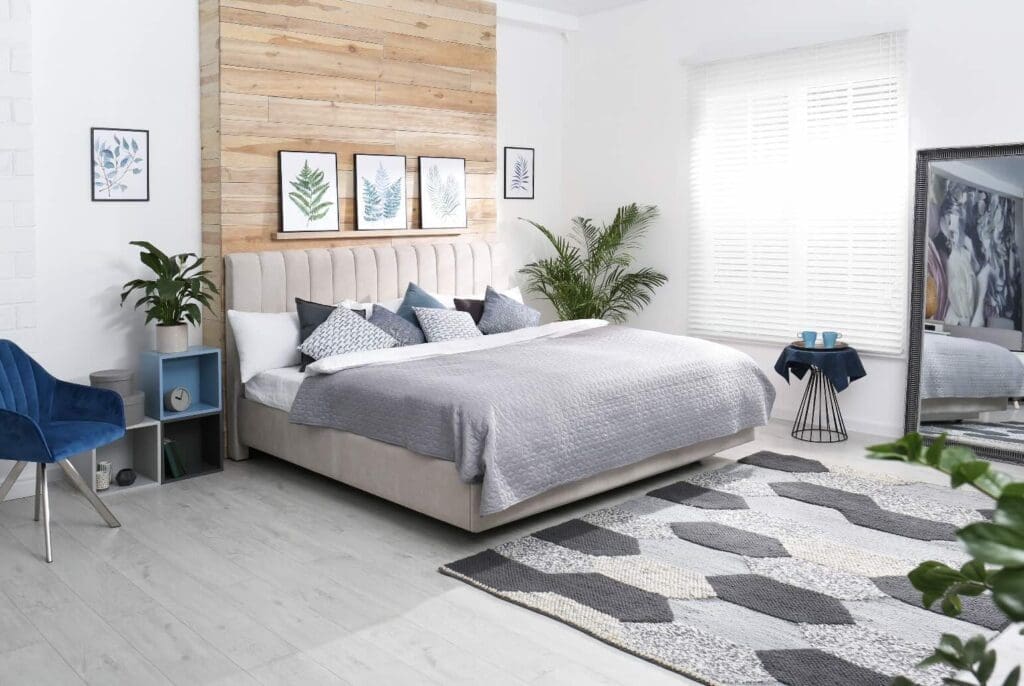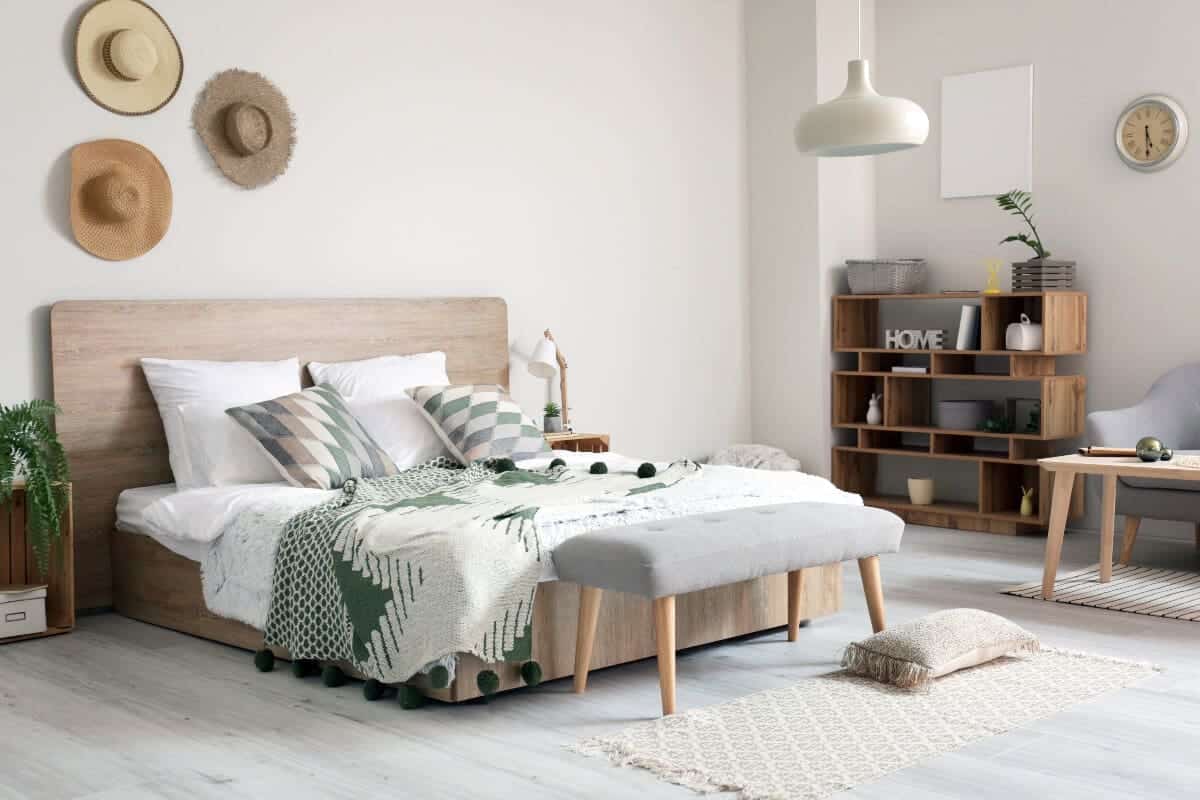The intimate cocoon of the bedroom, where we wind down and retreat from the external world, offers a blank canvas ripe for personal expression through interior design. Embracing the power of color, the bedroom can transform into a reflection of one’s innermost self. In this place, colors speak silently of one’s personality and influence the subtleties of mood and emotion.
Coupling the vivid language of hues with the rich vocabularies of texture and pattern, the bedroom space unfolds into a multi-dimensional sanctuary. A narrative woven with the ease of personal art and the strategic dance of lighting creates a visually engaging environment and an ode to the individual’s taste and creativity. The journey to crafting such an intimate space begins with understanding these elements and their interplay, a tapestry of design we will explore to inspire both serenity and aesthetics in your haven.
Table of Contents
- Choosing Your Color Palette
- Incorporating Texture and Patterns
- Integrating Personal Art and Design Elements
- Lighting as Art and Atmosphere
- Related Content
Choosing Your Color Palette
The Alchemy of Color: Transforming Your Bedroom into a Sanctuary
Imagine your bedroom as a canvas, where the every day begins and ends. It’s a sacred place, an intimate gallery showcasing the artistry of living. The power of a color palette is akin to the alchemist’s touch—transforming the mundane into the magical. Let us explore hues and shades, exploring how they can metamorphose a bedroom into a personal haven.
The Harmony of Hues
Embarking on a color journey begins with understanding the harmonious relationships between shades. Cool tones like blues and greens evoke tranquility, much like the hush of a forest or the ocean’s calm. In contrast, warm colors such as reds, oranges, and yellows can infuse your sanctum with a cozy, inviting glow reminiscent of a crackling hearth or the tender embrace of sunlight.
Color harmony achieves a visual symphony, with each tone supporting the next. Complemented by secondary hues, a primary color lays the foundation for a serene yet dynamic bedroom space.
Mood Induction Through Color
Color can sway emotions and set the stage for the desired ambiance. Desire a peaceful retreat to unwind? Soft pastels or neutrals create a minimalist, quiet atmosphere for relaxation and meditation. Are you yearning for inspiration and creativity? Bold, vibrant colors can stimulate the mind and awaken the senses, turning your bedroom into a muse’s enclave.
The mood of a room can change as quickly as one’s own, and selecting a palette that resonates emotionally is akin to curating an art exhibit with the intent to stir the soul.
The Illusion of Space
Color choices directly influence the perception of space within a bedroom. Light shades make a room feel more airy and expansive—a perfect trick for smaller bedrooms seeking a touch of spaciousness. When used thoughtfully, darker tones can create an intimate and cozy niche that seems to wrap around you like a velvet shawl.
With an understanding of light and reflection, one can manipulate hues to enhance or diminish the perception of space. Strategic placement of lighter and darker colors can highlight architectural features, draw the eye, and even alter the room’s perceived proportions.
Texture and Depth with Colors
Colors possess their texture, even beyond the tactile surfaces they cover. A matte finish can absorb light, softening the walls’ presence, while glossy shades can add a luxurious sheen that gives the room a dynamic quality. Layering colors through bedding, curtains, and accessories introduces different textures that interact with light and shadow, adding depth to the two-dimensional space.
A monochrome palette may offer a sleek, modern look, while splashes of contrasting colors can break the monotony, introducing visual interest and focal points to delight the beholder’s eye.
The Final Brushstroke
Curate your bedroom palette with intention, as each color is a brush stroke on your domestic canvas. Allow the colors to echo the essence of your personality, to resonate with the silent poetry of who you are. With each hue’s transformative power, shape your bedroom into more than a space for slumber: create a personal sanctuary where dreams are cradled in color and every waking moment is greeted with beauty.
Remember, a bedroom is not just a place but a reflection of self—and through the thoughtful application of color, it becomes a masterpiece of everyday living.

Incorporating Texture and Patterns
The Tapestry of Slumber: Weaving Texture and Patterns into Bedroom Aesthetics
Upon crossing the threshold of a bedroom, one’s senses are greeted not only by the symphony of colors but also by the tactile allure and visual rhythm created by texture and patterns.
These elements are as vital as color in fashioning a visually appealing and emotionally resonant habitat.
Texture speaks the language of touch, even when observed with the eyes. In a bedroom setting, texture adds depth and character, engaging the senses in a way that color alone cannot.
The plushness of a shaggy rug underfoot, the luxe feel of satin sheets, or the comforting embrace of a chunky knit throw—all contribute to the overall ambiance, creating layers of tactile responsiveness that enhance the sense of retreat and restfulness inherent to the space.
Moreover, different textures can evoke different feelings and atmospheres. Smooth, silken textures lend a sleek, sophisticated air, whereas rough, rustic weaves may conjure a sense of rugged coziness. Mixing and matching, such as crisp linen with soft velvet, introduces contrast that stimulates the senses and adds dynamic interest to the sleep sanctuary.
Patterns play no less a role in the artistry of bedroom design. Patterns inject personality into the room, from the hypnotic undulations of a chevron print to the orderly repetition of stripes or the unpredictable spontaneity of abstract designs.
They reflect the dweller’s essence, signaling boldness, tranquility, whimsy, or tradition.
The rhythm imposed by repetitive patterns can be visually soothing, setting the stage for relaxation and repose. However, striking a balance is critical; too much pattern can overwhelm, while too little may fail to make an impression.
Playing with scale is also instrumental—larger patterns can make a bold statement piece, such as on a feature wall or bedspread. In contrast, more minor, subtler patterns might serve as a gentle background or an accent, harmonizing with the more significant elements at play.
Patterns and texture also have the finesse to alter the perception of a room’s proportions. Vertical stripes can make ceilings appear higher, while horizontal patterns might make the room more expansive.
When placed strategically, textural elements can draw the eye and redirect focus. A tufted headboard or a collection of tapestries might become the centerpieces, shifting attention away from less desirable areas.
Whether in the opulent cascade of a velvet curtain or the strategic placement of a geometrically patterned rug, both texture and patterns amplify the sensory experience of a bedroom.
They bridge the gap between the functional and the aesthetic, fulfilling a desire for visual composition and a bedroom that genuinely feels like a refuge from life’s demands.
One crafts a visual tableau and a tactile, immersive environment by weaving texture and patterns into the bedroom fabric. It is an invitation to experience the room with all senses, harmonizing with its mood and embracing its restful embrace.
Through deliberate choices, as one would select the strokes for a canvas, the bedroom becomes not just another room but a profoundly personal artwork where one rests within the masterpiece every night.

Integrating Personal Art and Design Elements
Titillating Textures and Persuasive Patterns: The Artistic Touch That Transforms Bedrooms into Habitats of Inspiration
Nestled within the four walls of a bedroom, there lies a canvas ripe for the infusion of creativity and inspiration. Draping this sacred space in art, an embodiment of personal expression can serve as a perennial muse for those who dwell within.
The texture is akin to the whisper of a brushstroke — it appeals to our need for visual appeal and emotional resonance. Various textures add layers to a room, providing depth to create character-full vistas within an otherwise flat expanse.
Like the rich underpainting of a great masterpiece, textiles such as woven throws, fluffy rugs, and embroidered pillows lend tactile responsiveness to our everyday surroundings, forging an irresistible invitation to touch and explore.
Feather-soft or roughly hewn, the textures we choose punctuate our bedrooms, evoking atmospheres from the tranquil to the avant-garde. They are the script and the scenery of the interplay between light and shadow, creating nooks of comfort and walls that speak in silent verses of warmth.
Combining textures enamels our rooms in contrast. Linens against wood and metal accompanied by velvet—such marriages of surface enchant the senses, renew curiosity, and uphold the ceaseless dialogue between art and life. The interplay of textures makes our bedrooms a feast for the fingers, encouraging a tactile exploration akin to reading Braille poetry.
Patterns hold a complementary command in the bedroom symphony, their rhythms bringing forth the autobiographical elements of our inner worlds. They can resonate with the boldness of a statement piece or whisper gently in the cohesion of quiet design. Patterns are the rhythm section of the room; they create a subconscious beat that can either soothe or invigorate the spirit.
Embracing patterns is akin to curating a visual poem that speaks volumes of the dweller’s journey—every stripe, swirl, or geometric abstraction tells a tale. Harmonious or contrasting patterns in drapery, bedding, and artwork impart distinct moods and emotional currents.
Repetitive patterns can initiate a dance of the eyes, fostering a dynamic yet soothing interplay, setting the pulse of the bedroom to that of a serene retreat or a vibrant studio. The art in pattern selection lies in the delicate equilibrium between abundance and minimalism, ensuring the bedroom is not overwhelmed by visual noise but instead hums with the right frequency of individuality.
Patterns and textures can cunningly alter the perception of a room’s dimensions. They serve as subtle guides, drawing the gaze to intended focal points or expanding the sense of space through strategic placement—this manipulation of sight crafts an environment that fosters both autonomy and wonder.
In concert, texture, and pattern offer a sensual experience — the bedroom as a tactile, immersive environment beckons to be felt, lived in, and revealed within its boundaries. They encourage the occupant to perceive with all senses, embracing each element as part of a restful yet stimulating ambiance.
Ultimately, the bedroom is sculpted into a profoundly personal artwork; every choice in texture and pattern serves as an intentional stroke in the grand mural of the self. It becomes a habitat not just of sleep but of boundless inspiration.
Here, nestled under the soft armor of a hushed quilt or in the tender grip of light as it dances through patterned curtains, lies the reminder that one’s everyday life is a living, breathing work of art.

Lighting as Art and Atmosphere
The Luminescent Brushstroke: Why Lighting is the Final Touch in Bedroom Creation
In the art of bedroom design, once the palette of colors, textures, and patterns has been masterfully applied, lighting is one vital element that can either elevate the entire composition or dull the effects of even the most vibrant choices.
The glow from a lamp, the sheen of daylight filtering through curtains, or the flicker of a candle can transform the ambiance, making lighting the luminescent brushstroke in the canvas of bedroom creation.
The Symphony of Light and Shadow
As any seasoned artist knows, light is pivotal in how we perceive and feel within a space. When setting a room’s creative ambiance, carving out areas of light and shadow can create a dynamic visual experience.
Accent lighting can highlight artwork, sculptural elements, or reading nooks, giving them the prominence of a centerpiece. Conversely, shadows provide restful spots where the eyes can retreat, contributing to a more layered and reflective mood.
Color in a New Light
Previously, the considered approach to color in the bedroom was discussed; however, without proper lighting, these carefully chosen hues might not achieve their intended effect. Different types of lighting can significantly affect the appearance of colors.
Warm, yellow-toned lights enhance earthy and deep hues, providing a cozy glow perfect for a sanctuary-style retreat. More astonishing lights can bring out the crispness in blues and greens, vital for a more refreshing and awakening ambiance.
The Illumination of Emotion
The creative use of lighting in a bedroom can also influence the emotional tone of the environment. Soft, diffused lights lend themselves to a serene and calm atmosphere, while brighter, direct bulbs can energize and encourage focus. A dimmer switch is an artist’s tool in the bedroom, allowing one to adjust light intensity to suit the shifting moods and functions of the space.
Layering Light for Depth and Interest
As varying textures and patterns add complexity to a room, so do layering different lighting types. A blend of ceiling fixtures, table lamps, and floor lamps can deliver a customizable experience, mimicking the natural variation in sunlight over a day.
This catering to natural rhythms can enhance creativity and align the bedroom ambiance more closely with the cycles of the outside world.
The Functional Glow of Practicality
Lighting isn’t solely about ambiance; practical considerations must harmonize with aesthetics. Task lighting is fundamental for activities such as reading or dressing, ensuring functionality dances hand in hand with allure. When each light source has a defined role, the bedroom becomes a feast for the eyes and a stage for life’s everyday performances.
The Artistic Signature of Fixtures
Finally, the choice of lighting fixtures themselves acts as an extension of one’s artistic expression. A bold chandelier or an understated pendant can serve as the jewelry of the bedroom, making a statement that reflects one’s creative soul. It’s the final signature on a masterpiece, turning the room into a fully realized expression of personal style and artistic vision.
In conclusion, lighting is essential in crafting a bedroom’s creative ambiance. The sun to the interior landscape and the ever-changing natural spectrum highlight every stroke of creativity and crown the space with mood, depth, and life.
Whether seeking the hushed tones of an evening repose or the bright cheer of a morning’s awakening, remember that light, in its infinite forms and shades, is the silent but powerful element making every bedroom an artful habitation.

The artistry of bedroom design emerges from combining color, texture, and light, culminating in a space that does more than function—it tells a story. As the final brush strokes of lighting set the tone, the space becomes an embodiment of personal expression, a retreat that resonates with the unique identity of its inhabitants.
Though our exploration has traversed through the realms of design principles, the true magic lies in the freedom to interpret and integrate these ideas in ways that are uniquely yours, crafting a bedroom that is not only a place to rest but a bastion of personal narrative and comfort.
Let your bedroom be a testament to your individuality, and allow your choices today to echo tranquility and joy each time you cross its threshold.
If you are interested in seeing how Mondoro can be a valuable partner for your home decor and home furnishing products – we would love to talk to you to see how we can help you.
Find out more about how Mondoro can help you create, develop, and manufacture excellent home decor and home furniture products – don’t hesitate to contact me, Anita. Check out my email by clicking here or become a part of our community and join our newsletter by clicking here.
Mondoro gives out a FREE Lookbook to anyone interested. You can receive a copy of our latest Lookbook by clicking here.
Listen to our Podcast called Global Trade Gal. You can find it on all major podcast platforms. Try out to listen to one of our podcasts by clicking here.
Subscribe to our Mondoro Company Limited YouTube Channel filled with great videos and information by clicking here.
Related Content
What Is The Modern Farmhouse Interior Design Style?
The modern farmhouse interior design style has become increasingly popular as people look to create a warm and inviting home that reflects a more straightforward, rustic way of life. Combining classic farmhouse elements with contemporary design touches, this style blends the old and the new to create a comfortable and stylish living space.
You can discover more by reading What Is The Modern Farmhouse Interior Design Style?, by clicking here.
Many designers and furniture companies ask how they can protect their furniture and other designs from being copied. This is a worry of designers and creators everywhere.
How Can I Protect My Furniture Designs From Being Copied?
You can protect your furniture designs by making sure those you show them have a contract to view them and not copy them; also, make sure the designs are all dated and documented to show they are your original designs.
You can discover more by reading How Can I Protect My Furniture Designs From Being Copied? by clicking here.
Minimalist Interior Design Explored: Embracing The Trend
For quite some time, we’ve been dwelling in a society driven by excess, where more is often equated with better. However, the trend of minimalism stands in stark contrast to this ethos. Emphasizing the philosophy of ‘less is more,’ minimalism endorses choosing quality over sheer quantity. It encourages us to create interior spaces with an air of simplicity and tranquility rather than overwhelming opulence and clutter.
By clicking here, you can learn more by reading our blog, Minimalist Interior Design Explored: Embracing The Trend.

